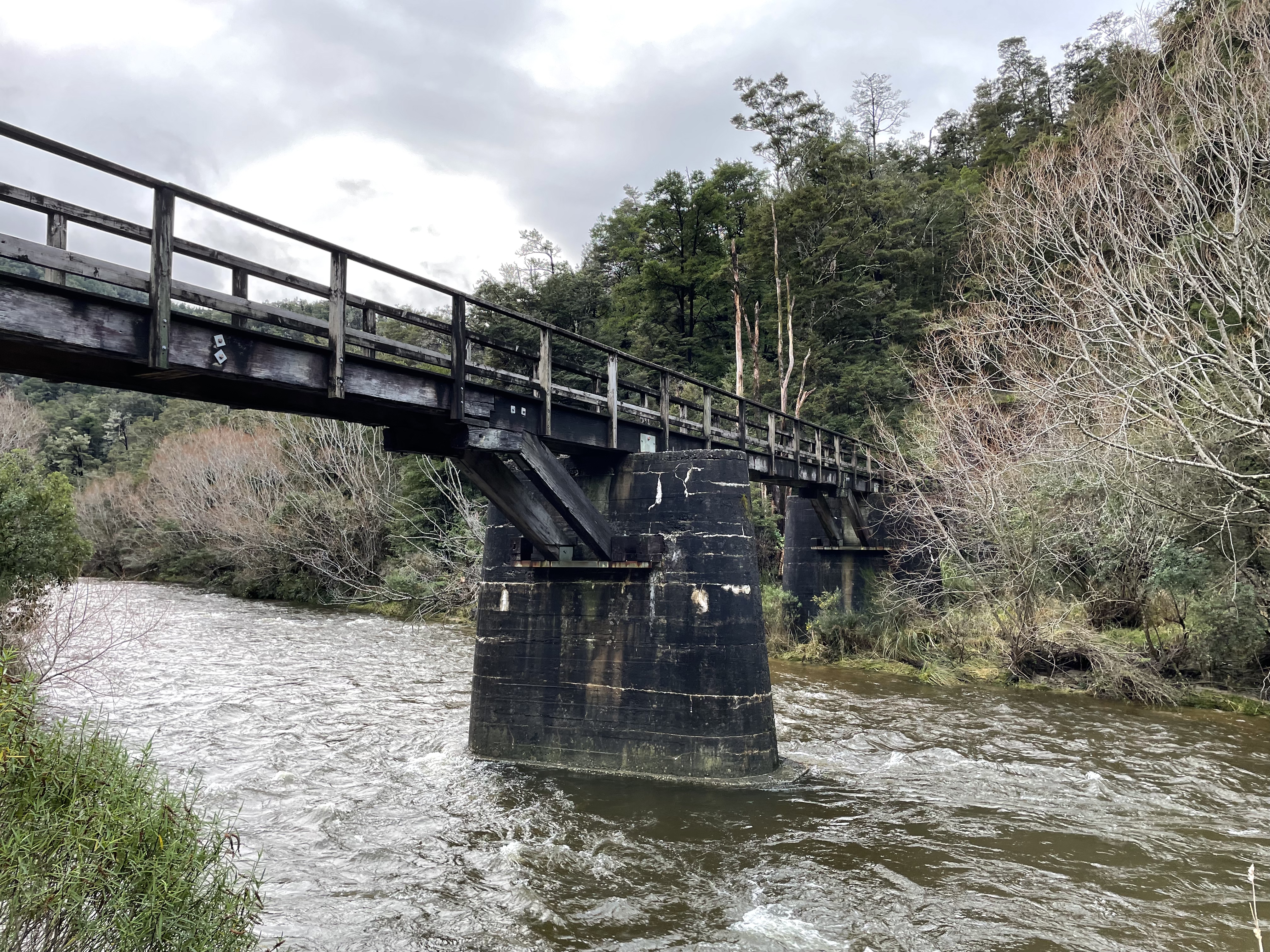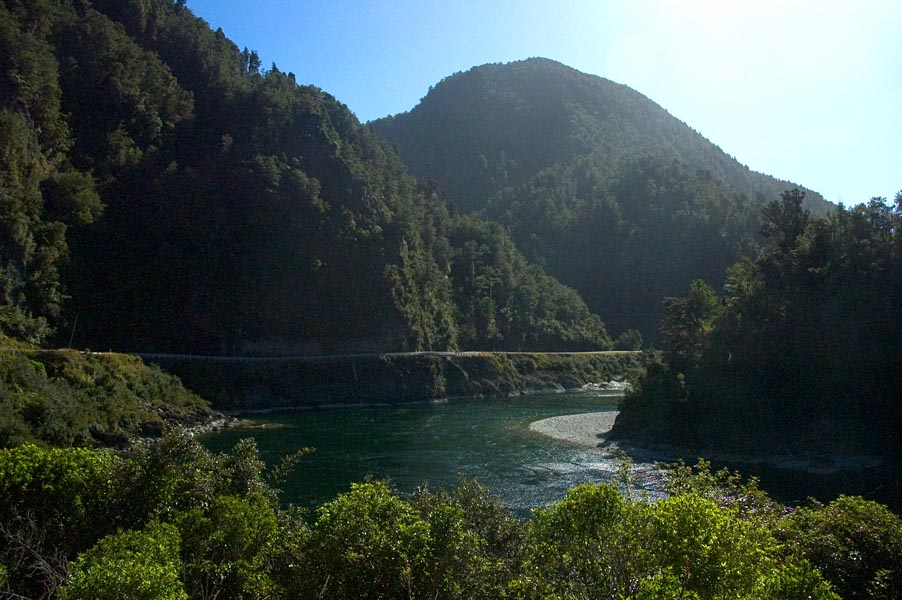|
Hope River (Tasman)
The Hope River is in the Tasman District of the South Island of New Zealand. It is the northernmost of three Hope Rivers in the South Island. The river rises on the eastern slopes of the Hope Range at heights of around . It flows east then south before joining the Buller River near Kawatiri Railway Station. A tributary called the Little Hope River rises near the Hope Saddle and flows southwest, joining the Hope River at Glenhope. follows the valley of the Hope and then the Little Hope as it climbs towards the Hope Saddle en route to Nelson. The river was named after G. W. Hope, who was secretary to Edward, Lord Stanley Earl of Derby ( ) is a title in the Peerage of England. The title was first adopted by Robert de Ferrers, 1st Earl of Derby, under a creation of 1139. It continued with the Ferrers family until the 6th Earl forfeited his property toward the end ..., the 14th Earl of Derby who later became Prime Minister of Great Britain.Wises New Zealand Guide, 7th Editi ... [...More Info...] [...Related Items...] OR: [Wikipedia] [Google] [Baidu] |
Buller River
The Buller River ( mi, Kawatiri) is a river in the South Island of New Zealand. One of the country's longest rivers, it flows for from Lake Rotoiti through the Buller Gorge and into the Tasman Sea near the town of Westport. Within the Buller Gorge and downstream from the Deepdale River joining, the Buller crosses from Tasman District into Buller District. The Paparoa Range separates the Buller River from the Grey River. A number of flora and fauna are found in the Buller catchment, many of these extending onto the slopes of the Paparoa Range. The river is named after Charles Buller, Member of Parliament in the United Kingdom of Great Britain and Ireland (UK) and director of the New Zealand Company, a UK-based company in the early 1800s with a royal charter supporting colonization efforts of New Zealand. The original Māori name for the Buller is ''Kawatiri''. The Buller River upstream from Murchison along with the Mangles River are popular for whitewater kayaking and rec ... [...More Info...] [...Related Items...] OR: [Wikipedia] [Google] [Baidu] |
New Zealand
New Zealand ( mi, Aotearoa ) is an island country in the southwestern Pacific Ocean. It consists of two main landmasses—the North Island () and the South Island ()—and over 700 smaller islands. It is the sixth-largest island country by area, covering . New Zealand is about east of Australia across the Tasman Sea and south of the islands of New Caledonia, Fiji, and Tonga. The country's varied topography and sharp mountain peaks, including the Southern Alps, owe much to tectonic uplift and volcanic eruptions. New Zealand's capital city is Wellington, and its most populous city is Auckland. The islands of New Zealand were the last large habitable land to be settled by humans. Between about 1280 and 1350, Polynesians began to settle in the islands and then developed a distinctive Māori culture. In 1642, the Dutch explorer Abel Tasman became the first European to sight and record New Zealand. In 1840, representatives of the United Kingdom and Māori chiefs ... [...More Info...] [...Related Items...] OR: [Wikipedia] [Google] [Baidu] |
Tasman District
Tasman District () is a local government district in the northwest of the South Island of New Zealand. It borders the Canterbury Region, West Coast Region, Marlborough Region and Nelson City. It is administered by the Tasman District Council, a unitary authority, which sits at Richmond, with community boards serving outlying communities in Motueka and Golden Bay / Mohua. The city of Nelson has its own unitary authority separate from Tasman District, and together they comprise a single region in some contexts, but not for local government functions or resource management (planning) functions. Name Tasman Bay, the largest indentation in the north coast of the South Island, was named after Dutch seafarer, explorer and merchant Abel Tasman. He was the first European to discover New Zealand on 13 December 1642 while on an expedition for the Dutch East India Company. Tasman Bay passed the name on to the adjoining district, which was formed in 1989 largely from the merger of Waim ... [...More Info...] [...Related Items...] OR: [Wikipedia] [Google] [Baidu] |
South Island
The South Island, also officially named , is the larger of the two major islands of New Zealand in surface area, the other being the smaller but more populous North Island. It is bordered to the north by Cook Strait, to the west by the Tasman Sea, and to the south and east by the Pacific Ocean. The South Island covers , making it the world's 12th-largest island. At low altitude, it has an oceanic climate. The South Island is shaped by the Southern Alps which run along it from north to south. They include New Zealand's highest peak, Aoraki / Mount Cook at . The high Kaikōura Ranges lie to the northeast. The east side of the island is home to the Canterbury Plains while the West Coast is famous for its rough coastlines such as Fiordland, a very high proportion of native bush and national parks, and the Fox and Franz Josef Glaciers. The main centres are Christchurch and Dunedin. The economy relies on agriculture and fishing, tourism, and general manufacturing and services. ... [...More Info...] [...Related Items...] OR: [Wikipedia] [Google] [Baidu] |
Hope River Rail Bridge
Hope is an optimistic state of mind that is based on an expectation of positive outcomes with respect to events and circumstances in one's life or the world at large. As a verb, its definitions include: "expect with confidence" and "to cherish a desire with anticipation." Among its opposites are dejection, hopelessness, and despair. In psychology Professor of Psychology Barbara Fredrickson argues that hope comes into its own when crisis looms, opening us to new creative possibilities. Frederickson argues that with great need comes an unusually wide range of ideas, as well as such positive emotions as happiness and joy, courage, and empowerment, drawn from four different areas of one's self: from a cognitive, psychological, social, or physical perspective. Hopeful people are "like the little engine that could, ecausethey keep telling themselves "I think I can, I think I can". Such positive thinking bears fruit when based on a realistic sense of optimism, not on a naive "fa ... [...More Info...] [...Related Items...] OR: [Wikipedia] [Google] [Baidu] |
Hope Range
Hope is an optimistic state of mind that is based on an expectation of positive outcomes with respect to events and circumstances in one's life or the world at large. As a verb, its definitions include: "expect with confidence" and "to cherish a desire with anticipation." Among its opposites are dejection, hopelessness, and despair. In psychology Professor of Psychology Barbara Fredrickson argues that hope comes into its own when crisis looms, opening us to new creative possibilities. Frederickson argues that with great need comes an unusually wide range of ideas, as well as such positive emotions as happiness and joy, courage, and empowerment, drawn from four different areas of one's self: from a cognitive, psychological, social, or physical perspective. Hopeful people are "like the little engine that could, ecausethey keep telling themselves "I think I can, I think I can". Such positive thinking bears fruit when based on a realistic sense of optimism, not on a naive "fal ... [...More Info...] [...Related Items...] OR: [Wikipedia] [Google] [Baidu] |
Kawatiri Railway Station
Kawatiri railway station was a rural railway station that served the small settlement of Kawatiri in the Tasman District of New Zealand’s South Island. Kawatiri is located on State Highway 6 at the junction with State Highway 63. It was one of 25 stations on the Nelson Section, and marked the furthest extent of Railways Department operations on the line. Kawatiri was one of the shortest-lived stations operated by the Railways Department: 5 years, 21 days between 1926 and 1931. The original intention was to extend the line to Inangahua Junction and Westport. Only the Westport-Inangahua section was built in the end. Kawatiri is situated in the Hope River gorge, with the Kahurangi National Park to the west and the Hope River to the east. State Highway 63 crossed the station yard via a bridge at the northern end of the yard, before crossing the Hope River and continuing on into the Wairau Valley. State Highway 6 passed by the station to the west between the station yard ... [...More Info...] [...Related Items...] OR: [Wikipedia] [Google] [Baidu] |
Hope Saddle
Hope Saddle ( above sea level) is a saddle located south of Richmond, in the Hope Range of the northern South Island The South Island, also officially named , is the larger of the two major islands of New Zealand in surface area, the other being the smaller but more populous North Island. It is bordered to the north by Cook Strait, to the west by the Tasman .... It lies above the Clark Valley. In 1871 a track was cut over the Hope Saddle ensuring there was a route from Westport to Nelson. Horse-drawn vehicles began using the track in 1879. This track would become part of State Highway 6. The view from the Hope Saddle is regarded as being "magnificent". References Mountain passes of New Zealand Landforms of the Tasman District State Highway 6 (New Zealand) {{Tasman-geo-stub ... [...More Info...] [...Related Items...] OR: [Wikipedia] [Google] [Baidu] |
Lord Stanley
Earl of Derby ( ) is a title in the Peerage of England. The title was first adopted by Robert de Ferrers, 1st Earl of Derby, under a creation of 1139. It continued with the Ferrers family until the 6th Earl forfeited his property toward the end of the reign of Henry III and died in 1279. Most of the Ferrers property and (by a creation in 1337) the Derby title were then held by the family of Henry III. The title merged in the Crown upon Henry IV's accession to the throne in 1399. The title was created again, this time for the Stanley family, in 1485. Lord Derby's subsidiary titles are Baron Stanley of Bickerstaffe in the County Palatine of Lancaster (created 1832), and Baron Stanley of Preston in the County Palatine of Lancaster (1886). The courtesy title of the heir apparent is Lord Stanley. The 1st to 5th Earls also held an earlier Barony of Stanley, created for the 1st Earl's father in 1456 and currently abeyant; the 2nd to 5th Earls held the Barony of Strange created in 12 ... [...More Info...] [...Related Items...] OR: [Wikipedia] [Google] [Baidu] |
Earl Of Derby
Earl of Derby ( ) is a title in the Peerage of England. The title was first adopted by Robert de Ferrers, 1st Earl of Derby, under a creation of 1139. It continued with the Ferrers family until the 6th Earl forfeited his property toward the end of the reign of Henry III and died in 1279. Most of the Ferrers property and (by a creation in 1337) the Derby title were then held by the family of Henry III. The title merged in the Crown upon Henry IV's accession to the throne in 1399. The title was created again, this time for the Stanley family, in 1485. Lord Derby's subsidiary titles are Baron Stanley of Bickerstaffe in the County Palatine of Lancaster (created 1832), and Baron Stanley of Preston in the County Palatine of Lancaster (1886). The courtesy title of the heir apparent is Lord Stanley. The 1st to 5th Earls also held an earlier Barony of Stanley, created for the 1st Earl's father in 1456 and currently abeyant; the 2nd to 5th Earls held the Barony of Strange created i ... [...More Info...] [...Related Items...] OR: [Wikipedia] [Google] [Baidu] |
Rivers Of The Tasman District
A river is a natural flowing watercourse, usually freshwater, flowing towards an ocean, sea, lake or another river. In some cases, a river flows into the ground and becomes dry at the end of its course without reaching another body of water. Small rivers can be referred to using names such as creek, brook, rivulet, and rill. There are no official definitions for the generic term river as applied to geographic features, although in some countries or communities a stream is defined by its size. Many names for small rivers are specific to geographic location; examples are "run" in some parts of the United States, "burn" in Scotland and northeast England, and "beck" in northern England. Sometimes a river is defined as being larger than a creek, but not always: the language is vague. Rivers are part of the water cycle. Water generally collects in a river from precipitation through a drainage basin from surface runoff and other sources such as groundwater recharge, springs, a ... [...More Info...] [...Related Items...] OR: [Wikipedia] [Google] [Baidu] |





